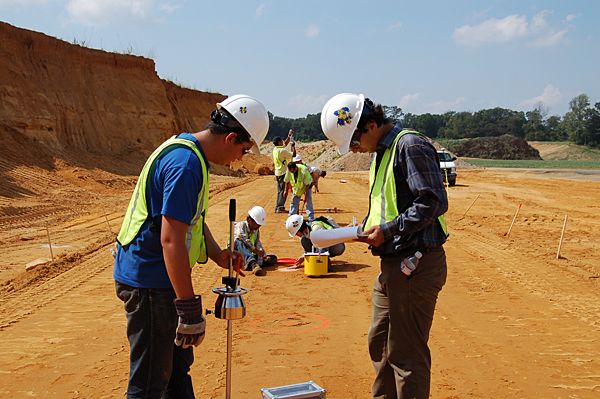The Advantages of Partnering with a Leading Consulting Engineer for Your Company Needs
The Advantages of Partnering with a Leading Consulting Engineer for Your Company Needs
Blog Article
The Interdisciplinary Approaches in the Geotechnical Sector: Linking the Void In Between Design, Geology, and Environmental Scientific Research for Optimal Project End Results
The combination of design, geology, and environmental scientific research within the geotechnical sector is not simply helpful; it is essential for accomplishing optimum project end results. What techniques might arise to facilitate this important collaboration and boost the effectiveness of geotechnical methods?
Relevance of Interdisciplinary Cooperation
The importance of interdisciplinary partnership in the geotechnical sector can not be overemphasized. Efficient geotechnical projects call for the combination of varied knowledge from various areas, including design, geology, and ecological science. This collaboration makes sure that all aspects of a task are taken into consideration, causing thorough solutions that resolve intricate difficulties.
When functioning in seclusion,Interdisciplinary cooperation fosters innovation by making it possible for experts to share insights and methodologies that may not be obvious. By leveraging the toughness of multiple techniques, teams can identify prospective dangers, optimize design processes, and improve the sustainability of geotechnical tasks. Such partnership advertises an alternative understanding of site-specific conditions, which is crucial for exact assessment and decision-making.
The intricacy of geotechnical projects demands a coordinated method to problem-solving. Eventually, interdisciplinary cooperation is vital for progressing best methods and accomplishing quality in the geotechnical market.
Secret Roles of Each Technique
Partnership among numerous techniques is not simply beneficial; it is crucial for the successful implementation of geotechnical jobs. Each self-control-- engineering, geology, and ecological science-- plays a distinctive yet interconnected duty that contributes to predict effectiveness and sustainability.
Geotechnical engineers are primarily in charge of making structures and ensuring architectural integrity. They examine dirt and rock properties to examine load-bearing capacities, offering important data for safe building and construction techniques. Their knowledge enables the formula of cutting-edge services to complex challenges.

Environmental researchers evaluate the potential effects of construction on environments and water resources. They perform environmental evaluations and develop reduction techniques to reduce unfavorable effects. By incorporating eco-friendly factors to consider, they ensure conformity with regulations and promote sustainability throughout the job lifecycle.
Study of Successful Integration
Successful integration of geotechnical techniques can be exemplified through various instance researches that highlight the efficiency of synergy in resolving complicated design obstacles. One significant example is the building and construction of the Hong Kong-- Zhuhai-- Macau Bridge, where a joint technique including geotechnical engineering, geology, and ecological science was vital. Geologists and designers operated in unison to analyze the seabed problems and maximize the structure layout, making reference certain security and lessening environmental impact.
An additional impactful case is the renovation of slope stability in the San Francisco Bay Area, where an interdisciplinary team incorporated geotechnical analysis with ecological assessments. By integrating hydrological studies and geological studies, the team properly identified possible landslide dangers and applied reliable mitigation measures, boosting safety and sustainability.
In addition, the redevelopment of Brownfield sites frequently needs a multidisciplinary strategy. In one situation in Chicago, partnership amongst geotechnical engineers, environmental researchers, and urban planners resulted in the successful remediation of contaminated soil, enabling the safe change of the website into a neighborhood park. These study highlight that interdisciplinary collaboration not just addresses technical challenges but likewise fosters ingenious options that benefit both jobs and neighborhoods.
Difficulties in Multidisciplinary Projects

Additionally, coordinating schedules and process among different teams can be troublesome, especially when each discipline has one-of-a-kind task milestones and deliverables. This misalignment can lead to delays and increased expenses. The obstacle of resource allocation also looms huge; ensuring that specialized knowledge is readily available at critical points requires careful preparation and foresight.
Finally, useful site governing conformity postures another considerable challenge. Each discipline might face various regulative frameworks, and straightening these requirements to fulfill task objectives can be time-consuming and complicated. Dealing with these difficulties requires solid leadership and efficient communication techniques to promote partnership and ensure that multidisciplinary teams function cohesively in the direction of shared objectives.
Future Trends in Geotechnical Practices
As the geotechnical sector advances, arising fads are reshaping practices to deal with the obstacles faced in multidisciplinary tasks - geotechnical engineers. One considerable pattern is the enhanced combination of innovative innovations, such as expert system and maker learning, right into geotechnical analysis and layout. These modern technologies boost predictive modeling and risk assessment, allowing designers to make image source more informed decisions throughout the project lifecycle

Additionally, the adoption of electronic twins and real-time tracking systems is coming to be much more common. These tools facilitate recurring analysis of soil conditions and architectural performance, enabling for timely treatments when issues arise.
Verdict
In verdict, the integration of design, geology, and environmental science is crucial for achieving optimal results in the geotechnical industry. Successful situation studies illustrate the benefits of this approach, while recognizing the obstacles encountered in multidisciplinary projects.
The combination of engineering, geology, and ecological science within the geotechnical industry is not simply beneficial; it is essential for attaining optimal task end results. Efficient geotechnical tasks require the combination of diverse expertise from numerous fields, including engineering, geology, and ecological scientific research.Browsing the complexities of multidisciplinary tasks in the geotechnical market presents several substantial challenges.As the geotechnical market progresses, arising trends are improving practices to address the difficulties faced in multidisciplinary projects. Geotechnical engineers are progressively collaborating with environmental scientists to guarantee that projects align with sustainability objectives and abide with regulative requirements.
Report this page